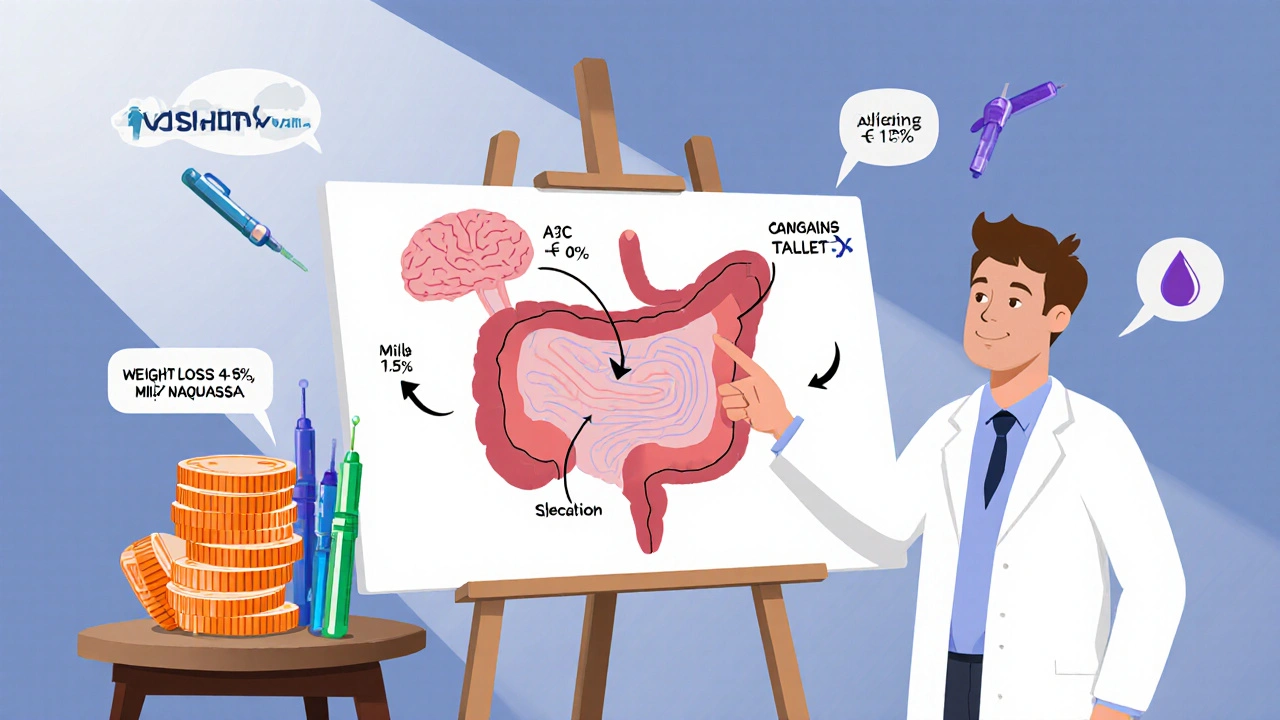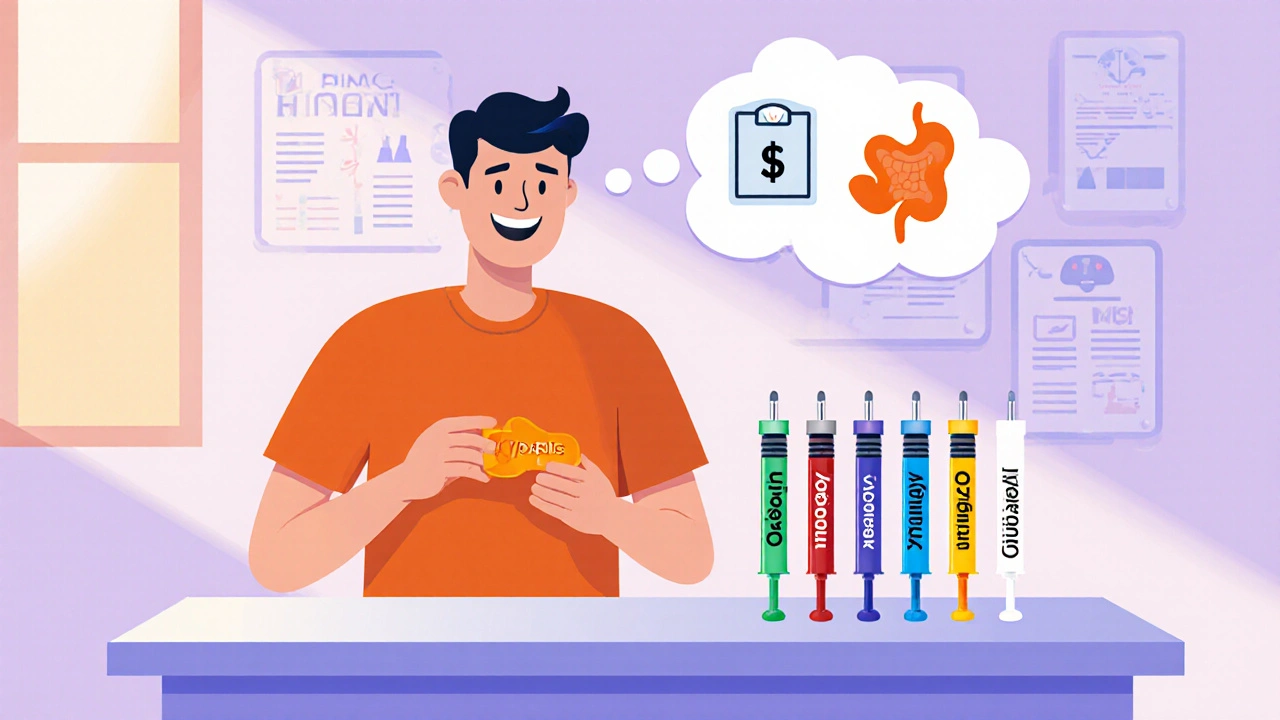GLP-1 Drug Comparison Tool
Personalized GLP-1 Selection Tool
Compare how different GLP-1 medications can help you reach your diabetes management and weight loss goals based on the latest clinical data.
Results
Key considerations: Rybelsus is the only oral option and may be preferred for needle-averse patients. Injections typically provide greater A1C reduction and weight loss, but may cause more gastrointestinal side effects.
If you’ve been hunting for a clear picture of how Rybelsus stacks up against the crowded GLP‑1 market, you’re in the right spot. This guide walks through what makes the oral semaglutide pill unique, how it measures up against injectable peers, and which factors-efficacy, side‑effects, cost, and lifestyle-should steer your choice.
What is Rybelsus (Semaglutide)?
Rybelsus is the first oral GLP‑1 receptor agonist approved by the FDA. Its active ingredient, Semaglutide, is a synthetic version of the gut hormone GLP‑1 that boosts insulin release, curbs glucagon, and slows gastric emptying. In the U.S., the pill received approval in 2019 for type 2 diabetes; Europe followed in 2020, and Australia listed it in 2021.
Rybelsus comes in 3mg, 7mg, and 14mg tablets taken once daily on an empty stomach, with a sip of water and a 30‑minute wait before any food or drink. This dosing schedule is designed to protect semaglutide from stomach acid and ensure consistent absorption.
How GLP‑1 Receptor Agonists Work
All GLP‑1 drugs mimic the natural hormone glucagon‑like peptide‑1. When blood glucose rises after a meal, GLP‑1 signals the pancreas to release insulin, tells the liver to stop producing glucose, and tells the brain that you’re full. The result: lower A1C, reduced appetite, and often modest weight loss. The class includes both injectables (e.g., Ozempic, Wegovy) and oral agents (Rybelsus).
Because semaglutide is chemically identical across products, the differences we see come from formulation (tablet vs. injection), dosage, and trial‑derived outcomes.
Head‑to‑Head Comparison of Rybelsus vs. Major Alternatives
Below is a concise snapshot of the most‑prescribed GLP‑1 drugs as of 2024. Numbers reflect pooled data from pivotal Phase3 trials (PIONEER for Rybelsus, SUSTAIN for injectable semaglutide, and SURPASS for tirzepatide). Values are averages; individual results can vary.
| Drug | Formulation | Approved Uses (2024) | A1C Reduction (avg) | Weight loss (avg %) | Common side effects |
|---|---|---|---|---|---|
| Rybelsus | Oral tablet | Type2 diabetes | ‑0.8% to ‑1.2% | 4‑6% | Nausea, abdominal pain, decreased appetite |
| Ozempic | Subcutaneous injection (weekly) | Type2 diabetes | ‑1.0% to ‑1.5% | 5‑7% | Nausea, vomiting, constipation |
| Wegovy | Subcutaneous injection (weekly) | Obesity (± type2 diabetes) | ‑1.3% to ‑1.8% (if diabetic) | 10‑15% | Nausea, diarrhea, gallbladder disease |
| Trulicity | Subcutaneous injection (weekly) | Type2 diabetes | ‑0.7% to ‑1.0% | 3‑5% | Nausea, abdominal discomfort, fatigue |
| Mounjaro (tirzepatide) | Subcutaneous injection (weekly) | Type2 diabetes, obesity (2023‑2024) | ‑1.5% to ‑2.0% | 12‑20% | Nausea, vomiting, dyspepsia |

Efficacy and Weight‑Loss Outcomes
Rybelsus delivers a respectable A1C drop of about 1% in most patients, a figure that mirrors the weekly 0.5mg dose of Ozempic but falls short of the 1.5% reduction seen with higher‑dose injectable semaglutide (2mg). When it comes to shedding pounds, the oral pill usually yields 4‑6% of baseline weight after a year of therapy. By contrast, Wegovy and Mounjaro regularly push patients into double‑digit percentages, making them the go‑to options for clinicians focused on obesity.
Why the gap? Bioavailability. Oral semaglutide is absorbed at roughly 1% of the injected form, so higher tablet doses are needed to match the systemic exposure of an injection. Still, for people averse to needles, the trade‑off can be acceptable.
Side‑Effect Profile
Gastro‑intestinal upset is the headline adverse event across the GLP‑1 class. Rybelsus tends to cause milder nausea than its injectable cousins, partly because the daily dose escalates more gradually (starting at 3mg, then 7mg, then 14mg). Injection‑related local reactions (redness, bruising) are absent with the tablet, which can be a deciding factor for those with sensitive skin.
Serious concerns-pancreatitis, medullary thyroid carcinoma, and severe gallbladder disease-are listed as warnings for all GLP‑1 agents. The risk remains low (<0.1% in large trials), but clinicians screen for personal or family histories before prescribing.
Cost and Access Considerations
Price is often the make‑or‑break factor. In the United States, a 30‑day supply of Rybelsus (14mg) averages around $850, while the same period of Ozempic (0.5mg) sits near $950. Wegovy, being marketed for weight loss, commands a premium of $1,300‑$1,500 per month. Australian PBS listings subsidize Rybelsus for eligible diabetes patients, dropping the out‑of‑pocket cost to under $30 a month, whereas injectables may require a specialist prescription and higher co‑pay.
Insurance formularies frequently place injectables in Tier2 or 3, meaning higher copays, while oral semaglutide gets a more favorable tier. For patients without coverage, pharmacy discount cards can shave 15‑25% off the retail price.
Choosing the Right Option - Decision Guide
Use the following quick‑check to see which GLP‑1 version fits your situation:
- Needle aversion? If you dread injections, Rybelsus is the only oral contender.
- Primary goal is weight loss >10%? Wegovy or Mounjaro deliver the biggest drops; Rybelsus may feel underwhelming.
- Insurance coverage? Review your plan’s formulary. Oral semaglutide often lands on a lower tier.
- Kidney function? All GLP‑1 drugs are safe down to eGFR30mL/min, but dose adjustments differ; discuss with your prescriber.
- Side‑effect tolerance? If past GLP‑1 exposure caused severe nausea, a slower‑titrated oral dose might be easier to handle.
Remember, switching between agents is possible, but a washout period (usually 1‑2 weeks) helps prevent overlapping side‑effects. Always coordinate with your healthcare provider before making changes.
Practical Tips for Starting Rybelsus
- Take the tablet with just a sip of water (no more than 4oz) after an overnight fast.
- Wait at least 30minutes before eating, drinking, or taking other meds.
- Begin at 3mg for 30days, then increase to 7mg; after another 30days, you can move to 14mg if needed.
- Track your blood glucose daily for the first two weeks to gauge response.
- Stay hydrated and consider a low‑fat, low‑sugar diet to ease gastrointestinal symptoms.
Frequently Asked Questions
Can I take Rybelsus if I’m already on insulin?
Yes, but your insulin dose will likely need reduction to avoid hypoglycemia. Your doctor should adjust the regimen based on glucose logs.
How fast does Rybelsus start lowering blood sugar?
Most patients see a modest drop within the first two weeks, with the full effect emerging after 12‑16 weeks of steady dosing.
Is Rybelsus safe during pregnancy?
GLP‑1 agonists are not recommended for pregnancy. If you become pregnant, discuss alternative diabetes management with your obstetrician.
What should I do if I miss a dose?
Take the missed tablet as soon as you remember, provided it’s still within the same day. If it’s already evening, skip it and resume the regular schedule next morning-don’t double up.
How does Rybelsus compare to Mounjaro for weight loss?
Mounjaro (tirzepatide) typically drives 12‑20% weight loss, nearly double the average from Rybelsus. However, Mounjaro is an injection and carries a slightly higher GI‑side‑effect profile.

